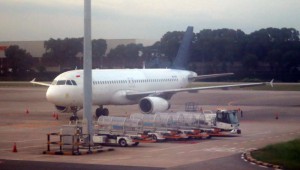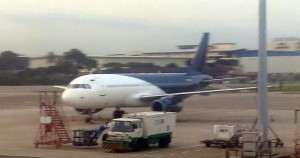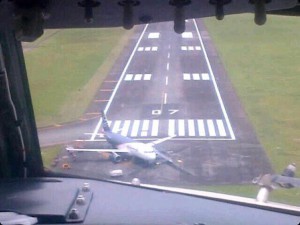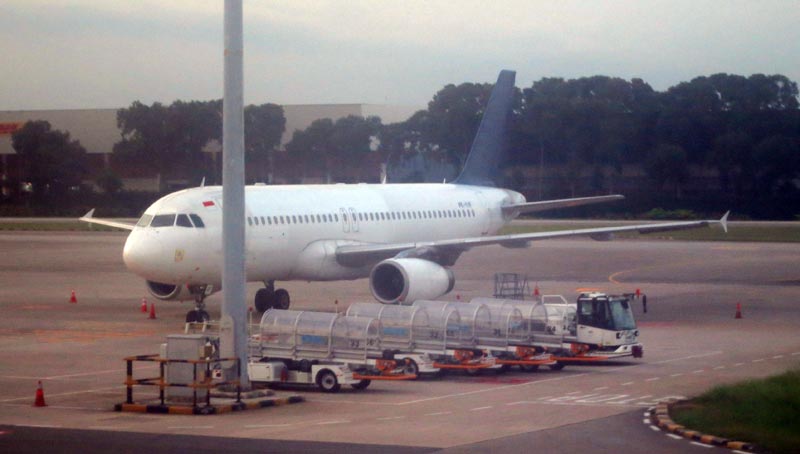 |
| PK-YVF spotting at Singapore Changi devoid of titles (Photo by: M. Aswin) |
 |
| Another (ex-) Batavia A320 devoid of titles in Singapore Changi. This one is suspected to be PK-YVH. (Photo by M. Aswin) |
- 2 Batavia A320s had been seen in Singapore, also parked together at the remote apron. Later I received pictures of the airplanes, both have had their logo and titles removed. The aircraft had been in Singapore since at least 16 May according to sources. One is identified to be PK-YVF and the other is suspected to be PK-YVH as the pair are reportedly leased from CIT.
- 1 737-400, PK-YVQ is reported to have been returned to the lessor.
- Both A330-200s are reportedly being prepared to be returned to lessor.
- Another sources, had said that Batavia have reduced its flight frequencies on several routes by at least 1 flight a day.
Allegations, allegations and allegations – Is Batavia in trouble?
There have been numerous allegations of safety violations/breaches against Batavia. Most of the allegations in the past have been on the subject of crew flight hour limits being exceeded, whether weekly, monthly, or annual limits, are so many that I’ve lost count and stopped trying to remember them. The last time I heard of the allegation was if I remember correctly, when it was alleged that a DGCA inspector asked a Batavia pilot at Jakarta’s airport waiting for his crew transport home, to show his flight log book, to which it was found that the crew had violated one of the periodic flight hour limitations. This reportedly led to immediate removal of the Operations Director.
Past allegations have also included questionable operational decisions, such as the company’s route to Luwuk, where former crews claimed that they were not given charts of Luwuk Airport and that the procedures for route and the airport was made up as they go along. One or two allegations regarding operations of aircraft with no-go maintenance issues have also been made (one claim involved an A320 being dispatched on a single IRS, and another claimed that weight limits were exceeded).
Note: The above are allegations and cannot be independently verified.
Poor Maintenance cause delays. A delay (that is not caused by weather or factors beyond the control of the airline which does not include maintenance) exceeding 3 hours now require IDR 300,000 (about US$32) per passenger, cash compensation to be given to the passengers. If an a 737 has 10 flights a day, and each is delayed by over 3 hours, that’s US$47,000 to US$55,000 in cash compensations. That amount is about the same as the monthly dry lease rate of an early 1990s built 737 classic. It takes no genius to figure out that delays caused by maintenance, is extremely expensive!
 |
| The overrun at Balikpapan in March was the second incident involving the aircraft in the last few months. |
The allegations mentioned above, are very hard to prove. We can believe in them or dismiss them as the claims aren’t independently verifiable. However, the findings by the NTSC on the recent A320 runway overrun at Balikpapan (“Update: Batavia A320 Overrun at BPN 12Mar12” (dated 23rd April 2012)), does provide insight into the potential problems. The NTSC found that:
- Batavia had not maintained the aircraft (involved in the incident) in accordance with the Airbus service bulletins, or even, Airbus’s recommendation regarding rectification of the cause of the previous incident involving the aircraft.
- It was also revealed that the airline disregarded the Airbus recommendation for the problem on the brake servos be solved prior to its next revenue flight (after 1st incident at Jayapura)
- It was found that the airline’s Technical Director was different from the Ops Spec submitted and approved by the DGCA.
A330 Ops: Batavia’s most descriptive bungle
- Last year Batavia had its bid rejected because it did not have landing permits for the Hajj flights or had not applied for it, Batavia rejected such notion, claiming that it had the landing permits for Jeddah (except that it is for tourist and business (ie: regular scheduled) flights, and not Hajj flights which is a separate permit).
- Instead of obtaining LOIs for aircraft leases, Batavia instead provided a loan commitment from a bank amounting to $1.3 million to lease aircraft for the hajj flights (something which is grossly inadequate, even for 1 aircraft!)
- Instead of obtaining an IATA Operational Safety Audit (IOSA) certification, they said that “we have secured an ISO certificate that guarantees our service and safety. That is the same,” according to Batavia’s commercial director Sukirno Sukirna. DGCA spokesman Bambang Ervan had to explain to the media the difference between an ISO and an IOSA.
- The ISO/IOSA games played by Batavia, isn’t bought by anyone, because in March, Batavia actually said they were after the IOSA and that they were going to commence the process in 2013, and that Sukirno Sukirna stated that one of the reason is to be able to qualify for the Hajj flight tenders.
Part 2 can be found HERE.


They have phased out all of their B737-200,if im not mistaken
I think they have, but the fleet lists still have Batavia as having 3.
it’s quite ‘official’ …
batavia ad on national newspaper mention ‘new’ surabaya based flight for jayapura, merauke, manokwari and sorong. they also updated their flight schedule as of may 21st adjusting 2 A320 and 1 B734 return to lessor
Well, last weekend we’re still getting TKG pax submitting full refunds to agents. Even the new “adjusted schedule” is questionable.
I suggest every air line to start offer cheap flights it is research that it can increase air traffic and revenue as well no matter how difficulty is facing by airline it can stand again by starting at zero level.